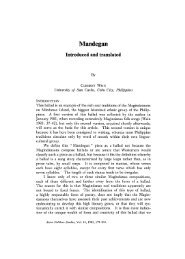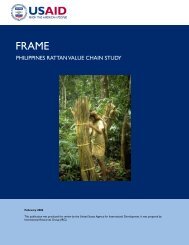Traditional games in the Philippines
Traditional games in the Philippines
Traditional games in the Philippines
You also want an ePaper? Increase the reach of your titles
YUMPU automatically turns print PDFs into web optimized ePapers that Google loves.
<strong>Traditional</strong> <strong>games</strong> <strong>in</strong> <strong>the</strong> Philipp<strong>in</strong>es<br />
These are <strong>games</strong> commonly played by children,<br />
usually us<strong>in</strong>g native materials or <strong>in</strong>struments. In <strong>the</strong><br />
Philipp<strong>in</strong>es, due to limited resources of toys of Filip<strong>in</strong>o<br />
children, <strong>the</strong>y usually come up on <strong>in</strong>vent<strong>in</strong>g <strong>games</strong> without<br />
<strong>the</strong> need of anyth<strong>in</strong>g but <strong>the</strong> players <strong>the</strong>mselves. With<br />
<strong>the</strong> flexibility of a real human to th<strong>in</strong>k and act makes <strong>the</strong><br />
game more <strong>in</strong>terest<strong>in</strong>g and challeng<strong>in</strong>g. Because it is a<br />
tradition for Filip<strong>in</strong>os to play <strong>in</strong> a bigger and spacious<br />
area, most <strong>games</strong> are usually played outside <strong>the</strong> house.<br />
Some <strong>games</strong> are played or held dur<strong>in</strong>g town fiestas <strong>in</strong> <strong>the</strong><br />
prov<strong>in</strong>ces. These <strong>games</strong> of Filip<strong>in</strong>o children <strong>in</strong>clude <strong>the</strong><br />
follow<strong>in</strong>g:<br />
Agawan Base<br />
There are two teams with two bases. How many players on each team<br />
depends on <strong>the</strong> players. There are two bases which each team claims as<br />
<strong>the</strong>ir own. The goal is to tag <strong>the</strong> o<strong>the</strong>r team's base without gett<strong>in</strong>g tagged.<br />
If you're tagged, you're transferred to <strong>the</strong> o<strong>the</strong>r team and must be rescued.<br />
There are several variations <strong>in</strong> which <strong>the</strong> rules are changed, <strong>in</strong> some, you<br />
can connect o<strong>the</strong>r items on <strong>the</strong> base so you can easily touch <strong>the</strong> base.There<br />
are usually set po<strong>in</strong>ts, such as first team to tag <strong>the</strong> o<strong>the</strong>r team 5 times<br />
w<strong>in</strong>s. You can tag o<strong>the</strong>r people who has touched <strong>the</strong>ir base before you and<br />
are on <strong>the</strong> opposite team. If <strong>the</strong>y've touched <strong>the</strong>ir base after you've touched<br />
your base, <strong>the</strong>y can tag you, and you can't tag <strong>the</strong>m.
Agawang sulok<br />
- catch and own a corner - The it or tagger stands <strong>in</strong> <strong>the</strong> middle of <strong>the</strong><br />
ground. The players <strong>in</strong> <strong>the</strong> corners will try to exchange places by runn<strong>in</strong>g<br />
from one base to ano<strong>the</strong>r. The it should try to secure a corner or base by<br />
rush<strong>in</strong>g to any of those when it is vacant. This is called "agawan base" <strong>in</strong><br />
some variants, and "bilaran" <strong>in</strong> o<strong>the</strong>rs<br />
Araw-Lilim<br />
- sun and shade - The it or tagger tries to tag or touch any of <strong>the</strong> players<br />
who is <strong>in</strong> direct contact with <strong>the</strong> light.<br />
Bahay-Bahayan<br />
A role-play<strong>in</strong>g game where children act as members of an imag<strong>in</strong>ary family,<br />
sometimes to <strong>the</strong> extent that one of <strong>the</strong>m becomes <strong>the</strong> family "pet." They<br />
<strong>the</strong>n act out various household situations such as d<strong>in</strong>ner, go<strong>in</strong>g to mass, and<br />
<strong>the</strong> like.<br />
Bahay-Kubo<br />
A hand-clapp<strong>in</strong>g game generally <strong>in</strong>volv<strong>in</strong>g 4 people. They are split <strong>in</strong>to two<br />
pairs, a pair hav<strong>in</strong>g 2 people fac<strong>in</strong>g each o<strong>the</strong>r, and all members from both<br />
pairs fac<strong>in</strong>g <strong>the</strong> center (<strong>the</strong> two pairs be<strong>in</strong>g perpendicular to each o<strong>the</strong>r).<br />
Each pair <strong>the</strong>n does a hand clapp<strong>in</strong>g "rout<strong>in</strong>e" while s<strong>in</strong>g<strong>in</strong>g <strong>the</strong> "bahay<br />
kubo." At <strong>the</strong> middle of <strong>the</strong> song, each pair exchanges "rout<strong>in</strong>es" with <strong>the</strong><br />
o<strong>the</strong>r.
Bati-Cobra<br />
This is a hitt<strong>in</strong>g and catch<strong>in</strong>g game. This game is played outdoors only by<br />
two or more players.<br />
To play this game, 2 pieces of bamboo sticks (1 long, 1 short) are required.<br />
A player acts as a batter and stands opposite <strong>the</strong> o<strong>the</strong>rs players at a<br />
distance. The batter holds <strong>the</strong> long bamboo stick with one hand and tosses<br />
<strong>the</strong> short one with <strong>the</strong> o<strong>the</strong>r hand. The batter <strong>the</strong>n strikes <strong>the</strong> shorter stick<br />
with <strong>the</strong> longer stick. The o<strong>the</strong>r players will attempt to catch <strong>the</strong> fly<strong>in</strong>g<br />
shorter stick. Whoever catches <strong>the</strong> stick gets <strong>the</strong> turn to be <strong>the</strong> next batter.<br />
If nobody catches <strong>the</strong> stick, any player can pick it up. The batter <strong>the</strong>n puts<br />
down <strong>the</strong> longer stick on <strong>the</strong> ground. The holder of <strong>the</strong> shorter stick will<br />
throw it with <strong>the</strong> attempt to hit <strong>the</strong> longer stick on <strong>the</strong> ground. If <strong>the</strong><br />
longer stick is hit, <strong>the</strong> hitter becomes <strong>the</strong> next Batter. If <strong>the</strong> player with<br />
<strong>the</strong> shorter stick misses to hit <strong>the</strong> longer one, <strong>the</strong> same batter will<br />
cont<strong>in</strong>ue.<br />
Bulong-Pari<br />
- whisper it to <strong>the</strong> priest - It is composed of two teams and an it. The<br />
leader of team A goes to <strong>the</strong> priest and whispers one of <strong>the</strong> names of <strong>the</strong><br />
players of team B. Then he returns to his place and <strong>the</strong> priest calls out,<br />
"Lapit!" ("Approach!"). One of <strong>the</strong> players of team B should approach <strong>the</strong><br />
priest, and if it happens to be <strong>the</strong> one whom <strong>the</strong> leader of team A<br />
mentioned, <strong>the</strong> priest will say, "Boom" or "Bung!" The player <strong>the</strong>n falls out<br />
of l<strong>in</strong>e and stays somewhere near <strong>the</strong> priest as a prisoner.<br />
Buwan-Buwan<br />
A rough circle is drawn on <strong>the</strong> ground and one person from <strong>the</strong> group is<br />
tagged. He is not allowed to enter <strong>the</strong> circle, but <strong>in</strong>stead has to touch one<br />
of <strong>the</strong> people <strong>in</strong>side <strong>the</strong> circle without hav<strong>in</strong>g entered it. If he succeeds, he<br />
can enter <strong>the</strong> circle, and <strong>the</strong> person touched becomes <strong>the</strong> next one tagged.<br />
Calahoyo ("Hole-<strong>in</strong>")<br />
This is an outdoor game by two to ten players. Accurate target<strong>in</strong>g is <strong>the</strong><br />
skill developed <strong>in</strong> this game because <strong>the</strong> objective of each player is to hit<br />
<strong>the</strong> anak (small stones or objects) with <strong>the</strong> use of <strong>the</strong> pamato (big, flat<br />
stone), try<strong>in</strong>g to send it to <strong>the</strong> hole.<br />
A small hole is dug <strong>in</strong> <strong>the</strong> ground, and a throw<strong>in</strong>g l<strong>in</strong>e is drawn opposite <strong>the</strong><br />
hole (approx 5 to 6 metres (16 to 20 ft) away from <strong>the</strong> hole). A longer l<strong>in</strong>e<br />
is drawn between <strong>the</strong> hole and <strong>the</strong> throwe<strong>in</strong>g l<strong>in</strong>e. Each player has a<br />
pamato and an anak. All <strong>the</strong> anak are placed on <strong>the</strong> throw<strong>in</strong>g l<strong>in</strong>e, and
players try to throw <strong>the</strong>ir pamato <strong>in</strong>to <strong>the</strong> hole from <strong>the</strong> throw<strong>in</strong>g l<strong>in</strong>e. The<br />
Player whose pamato is <strong>in</strong> <strong>the</strong> hole or nearest <strong>the</strong> hole will have <strong>the</strong> chance<br />
for <strong>the</strong> first throw. Us<strong>in</strong>g <strong>the</strong> pamato, <strong>the</strong> first thrower tries to hit <strong>the</strong><br />
anak, attempt<strong>in</strong>g to send it to <strong>the</strong> hole. Players take turns <strong>in</strong> hitt<strong>in</strong>g <strong>the</strong>ir<br />
anak until one of <strong>the</strong>m gets <strong>in</strong>to <strong>the</strong> hole, with <strong>the</strong> players tak<strong>in</strong>g turns a<br />
complete round and so on. The game goes on until only one anak is left<br />
outside <strong>the</strong> hole. All players who get <strong>the</strong>ir anak <strong>in</strong>side <strong>the</strong> hole are declared<br />
w<strong>in</strong>ners, while <strong>the</strong> one with <strong>the</strong> anak left outside <strong>the</strong> hole is<br />
<strong>the</strong> alila (loser) or muchacho. Alila orMuchacho will be 'punished' by all <strong>the</strong><br />
w<strong>in</strong>ner/s as follows:<br />
• W<strong>in</strong>ners stand at <strong>the</strong> throw<strong>in</strong>g l<strong>in</strong>e with <strong>the</strong>ir anak beyond l<strong>in</strong>e A-B<br />
(longer l<strong>in</strong>e between hole and throw<strong>in</strong>g l<strong>in</strong>e). The w<strong>in</strong>ners hit <strong>the</strong>ir anak<br />
with <strong>the</strong>ir pamato. The muchacho picks up <strong>the</strong> pamato and returns it to <strong>the</strong><br />
owner. The w<strong>in</strong>ners repeat throw<strong>in</strong>g as <strong>the</strong> muchacho keeps on pick<strong>in</strong>g up<br />
and return<strong>in</strong>g <strong>the</strong> pamato as punishment. W<strong>in</strong>ners who fail to hit <strong>the</strong>ir<br />
respective anak will stop throw<strong>in</strong>g. The objective is to tire <strong>the</strong> loser as<br />
punishment. When all are through, <strong>the</strong> game starts aga<strong>in</strong>.<br />
Ch<strong>in</strong>ese Garter<br />
Two people hold both ends of a stretched garter horizontally while <strong>the</strong><br />
o<strong>the</strong>rs attempt to cross over it. The goal is to cross without hav<strong>in</strong>g tripped<br />
on <strong>the</strong> garter. With each round, <strong>the</strong> garter's height is made higher than <strong>the</strong><br />
previous round (<strong>the</strong> game starts with <strong>the</strong> garter at ankle-level, followed by<br />
knee-level, until <strong>the</strong> garter is positioned above <strong>the</strong> head). The higher<br />
rounds demand dexterity, and <strong>the</strong> players generally leap with <strong>the</strong>ir feet<br />
first <strong>in</strong> <strong>the</strong> air, so <strong>the</strong>ir feet cross over <strong>the</strong> garter, and <strong>the</strong>y end up land<strong>in</strong>g<br />
on <strong>the</strong> o<strong>the</strong>r side. Also, with <strong>the</strong> higher levels, do<strong>in</strong>g cartwheels to "cross"<br />
<strong>the</strong> garter is allowed.
Ir<strong>in</strong>g-Ir<strong>in</strong>g<br />
- go round and round until <strong>the</strong> hanky drops - After <strong>the</strong> it is determ<strong>in</strong>ed, he<br />
or she goes around <strong>the</strong> circle and drops a handkerchief beh<strong>in</strong>d one of <strong>the</strong><br />
players <strong>in</strong> <strong>the</strong> circle. If this player notices <strong>the</strong> handkerchief, he or she has<br />
to pick up <strong>the</strong> handkerchief and go after <strong>the</strong> it around <strong>the</strong> circle. The it has<br />
to reach <strong>the</strong> vacant spot left by <strong>the</strong> player before <strong>the</strong> itis tagged;<br />
o<strong>the</strong>rwise, <strong>the</strong> it has to take <strong>the</strong> handkerchief and repeat <strong>the</strong> process all<br />
over aga<strong>in</strong>.<br />
Juego de Anillo<br />
A game notably Spanish <strong>in</strong> <strong>in</strong>fluence. The name literally translates to "game<br />
of r<strong>in</strong>gs." It <strong>in</strong>volves rid<strong>in</strong>g a horse while hold<strong>in</strong>g a dagger and "catch<strong>in</strong>g"<br />
r<strong>in</strong>gs hang<strong>in</strong>g from a tree or some o<strong>the</strong>r structure us<strong>in</strong>g <strong>the</strong> dagger.<br />
Juego de Prenda<br />
- game of look<strong>in</strong>g for <strong>the</strong> miss<strong>in</strong>g bird - There is no limit to <strong>the</strong> number of<br />
players that can play. Players sit <strong>in</strong> a circle with <strong>the</strong> leader <strong>in</strong> <strong>the</strong> middle.<br />
Each player adopts a name of a tree or flower that is given by <strong>the</strong> leader.<br />
The leader recounts <strong>the</strong> story of a lost bird that was owned by a k<strong>in</strong>g. He or<br />
she says, The bird of <strong>the</strong> k<strong>in</strong>g was lost yesterday. Did you f<strong>in</strong>d it, Ylang-<br />
Ylang? The player who adopted <strong>the</strong> name of <strong>the</strong> Ylang-Ylang tree at once<br />
answers that he or she has not found it, so <strong>the</strong> leader cont<strong>in</strong>ues to ask <strong>the</strong><br />
o<strong>the</strong>r trees whe<strong>the</strong>r <strong>the</strong> bird has hidden <strong>in</strong> <strong>the</strong>m. If a player cannot answer<br />
after <strong>the</strong> third count, he or she is made to deposit a th<strong>in</strong>g he or she owns to<br />
<strong>the</strong> leader until <strong>the</strong> leader has been able to ga<strong>the</strong>r a lot of th<strong>in</strong>gs from <strong>the</strong><br />
members.<br />
Kapitang Bakod<br />
- touch <strong>the</strong> post, or you're it! or hold on to <strong>the</strong> fence - When <strong>the</strong> it or<br />
tagger is chosen, <strong>the</strong> o<strong>the</strong>r players run from place to place and save<br />
<strong>the</strong>mselves from be<strong>in</strong>g tagged by hold<strong>in</strong>g on to a fence, a post, or any<br />
object made of wood or bamboo.<br />
Langit-Lupa<br />
- heaven and earth - One "It" chases after players who are allowed to run on<br />
level ground (lupa) and clamber over objects (langit). The "It" may tag<br />
players who rema<strong>in</strong> on <strong>the</strong> ground, but not those who are stand<strong>in</strong>g <strong>in</strong> <strong>the</strong><br />
"langit" (heaven). The tagged player <strong>the</strong>n becomes "It" and <strong>the</strong> game<br />
cont<strong>in</strong>ues.
Law<strong>in</strong> at Sisiw ("Hawk and Chicken")<br />
This game is played by 10 or more players. It can be played <strong>in</strong>doors or<br />
outdoors.<br />
One player is chosen as <strong>the</strong> 'hawk' and ano<strong>the</strong>r as <strong>the</strong> 'hen'. The o<strong>the</strong>r<br />
players are <strong>the</strong> 'chickens'. The chickens stand one beh<strong>in</strong>d <strong>the</strong> o<strong>the</strong>r, each<br />
hold<strong>in</strong>g <strong>the</strong> waist of <strong>the</strong> one <strong>in</strong> front. The hen stands <strong>in</strong> front of <strong>the</strong> file of<br />
chickens.<br />
The hawk will 'buy' a chicken from <strong>the</strong> hen. The hawk will <strong>the</strong>n take <strong>the</strong><br />
chicken, asks him/her to hunt for food and goes to sleep. While <strong>the</strong> hawk is<br />
asleep, <strong>the</strong> chicken will return to <strong>the</strong> hen. The Hawk wakes up and tries to<br />
get back <strong>the</strong> chicken he bought while <strong>the</strong> hen and o<strong>the</strong>r chickens prevent<br />
<strong>the</strong> hawk from catch<strong>in</strong>g <strong>the</strong> chicken. If <strong>the</strong> hawk succeeds, <strong>the</strong> chicken is<br />
taken and punished. If <strong>the</strong> hawk fails to catch <strong>the</strong> chicken, <strong>the</strong> hawk will<br />
try to buy ano<strong>the</strong>r chicken.<br />
Luksong-Baka<br />
- jump over <strong>the</strong> cow - A popular variation of Luksong T<strong>in</strong>ik, one player<br />
crouches while <strong>the</strong> o<strong>the</strong>r players jump over him/her. The crouch<strong>in</strong>g player<br />
gradually stands up as <strong>the</strong> game progresses, mak<strong>in</strong>g it harder for <strong>the</strong> o<strong>the</strong>r<br />
players to jump over him/her.
Luksong-T<strong>in</strong>ik<br />
- jump over <strong>the</strong> thorns - Two players serve as <strong>the</strong> base of <strong>the</strong> t<strong>in</strong>ik (thorn)<br />
by putt<strong>in</strong>g <strong>the</strong>ir right or left feet toge<strong>the</strong>r (soles touch<strong>in</strong>g gradually build<strong>in</strong>g<br />
<strong>the</strong> t<strong>in</strong>ik). A start<strong>in</strong>g po<strong>in</strong>t is set by all <strong>the</strong> players, giv<strong>in</strong>g enough runway<br />
for <strong>the</strong> players to achieve a higher jump, so as not to hit <strong>the</strong> t<strong>in</strong>ik. Players<br />
of <strong>the</strong> o<strong>the</strong>r team start jump<strong>in</strong>g over <strong>the</strong> t<strong>in</strong>ik, followed by <strong>the</strong> o<strong>the</strong>r team<br />
members.<br />
Palosebo<br />
- greased bamboo pole climb<strong>in</strong>g - This game <strong>in</strong>volves a greased bamboo<br />
pole that players attempt to climb. This <strong>games</strong> is usually played dur<strong>in</strong>g<br />
town fiestas, particularly <strong>in</strong> <strong>the</strong> prov<strong>in</strong>ces. The objective of <strong>the</strong> participants<br />
is to be <strong>the</strong> first person to reach <strong>the</strong> prize—a small bag—located at <strong>the</strong> top<br />
of <strong>the</strong> bamboo pole. The small bag usually conta<strong>in</strong>s money or toys.
Pat<strong>in</strong>tero<br />
Harangang taga - try to cross my l<strong>in</strong>e without lett<strong>in</strong>g me touch or catch<br />
you - Each member of <strong>the</strong> group who is it stands on <strong>the</strong> water l<strong>in</strong>es. The<br />
perpendicular l<strong>in</strong>e <strong>in</strong> <strong>the</strong> middle allows <strong>the</strong> it designated on that l<strong>in</strong>e to<br />
<strong>in</strong>tersect <strong>the</strong> l<strong>in</strong>es occupied by <strong>the</strong> it that <strong>the</strong> parallel l<strong>in</strong>e <strong>in</strong>tersects, thus<br />
<strong>in</strong>creas<strong>in</strong>g <strong>the</strong> chances of <strong>the</strong> runners to be trapped.even only one(1)<br />
member of a group is tagged <strong>the</strong> whole group will be <strong>the</strong> "it".<br />
Piko<br />
hopscotch- The players stand beh<strong>in</strong>d <strong>the</strong> edge of a box, and each should<br />
throw <strong>the</strong>ir cue ball. The first to play is determ<strong>in</strong>ed depend<strong>in</strong>g on <strong>the</strong><br />
players' agreement (e.g. nearest to <strong>the</strong> moon, w<strong>in</strong>gs or chest). Whoever<br />
succeeds <strong>in</strong> throw<strong>in</strong>g <strong>the</strong> cue ball nearest to <strong>the</strong> place that <strong>the</strong>y have<br />
agreed upon will play first. The next nearest is second, and so on.
Pitik-Bulag<br />
This game <strong>in</strong>volves 2 players. One covers his eyes with a hand while <strong>the</strong><br />
o<strong>the</strong>r flicks a f<strong>in</strong>ger (pitik) over <strong>the</strong> hand cover<strong>in</strong>g <strong>the</strong> eyes. The person<br />
with <strong>the</strong> covered eyes gives a number with his hand <strong>the</strong> same time <strong>the</strong><br />
o<strong>the</strong>r does. If <strong>the</strong>ir numbers are <strong>the</strong> same, <strong>the</strong>n <strong>the</strong>y exchange roles <strong>in</strong> <strong>the</strong><br />
game.<br />
Sambunot<br />
Sambunot is a Philipp<strong>in</strong>e game which may be played outdoors by ten or<br />
more players, but not to exceed twenty. The goal <strong>in</strong> <strong>the</strong> game is to get <strong>the</strong><br />
coconut husk out of <strong>the</strong> circle.<br />
A circle is drawn on <strong>the</strong> floor, big enough to accommodate <strong>the</strong> number of<br />
players. A coconut husk is placed at <strong>the</strong> center of <strong>the</strong> circle. The players<br />
position <strong>the</strong>mselves <strong>in</strong>side <strong>the</strong> circle. At <strong>the</strong> signal ″GO,″ players will rush to<br />
<strong>the</strong> center to get <strong>the</strong> coconut husk. Players may steal <strong>the</strong> coconut husk<br />
from ano<strong>the</strong>r player <strong>in</strong> an attempt to be <strong>the</strong> one to take <strong>the</strong> husk put of <strong>the</strong><br />
circle. A player who is successful <strong>in</strong> gett<strong>in</strong>g out of <strong>the</strong> circle with <strong>the</strong><br />
coconut husk w<strong>in</strong>s, and <strong>the</strong> game starts aga<strong>in</strong>.
Sipa<br />
- game of kick - The object be<strong>in</strong>g used to play <strong>the</strong> game is also called sipa.<br />
It is made of a washer with colorful threads, usually plastic straw, attached<br />
to it. The sipa is <strong>the</strong>n thrown upwards for <strong>the</strong> player toss us<strong>in</strong>g his/her foot.<br />
The player must not allow <strong>the</strong> sipa to touch <strong>the</strong> ground by hitt<strong>in</strong>g it several<br />
times with his/her foot, and sometimes <strong>the</strong> part just above <strong>the</strong> knee. The<br />
player must count <strong>the</strong> number of times he/she was able to kick <strong>the</strong> sipa.<br />
The one with most number of kicks w<strong>in</strong>s <strong>the</strong> game. Sipa is also <strong>the</strong> term<br />
used for <strong>the</strong> Filip<strong>in</strong>o variant of Sepak Takraw.this game is<br />
called"pambansang laro".<br />
Taguan<br />
- hide and seek <strong>in</strong> America. What is unique <strong>in</strong> Tagu-Taguan compared to<br />
its counterpart, hide and seek, is that this game is usually played at sunset<br />
or at night as a challenge for <strong>the</strong> it to locate those who are hid<strong>in</strong>g.<br />
Takip-Silim<br />
- twilight game, look out, cover yourself! or take-cover game! -<br />
Participants usually step on couches, hide under tables, or wrap <strong>the</strong>mselves<br />
<strong>in</strong> curta<strong>in</strong>s – much to <strong>the</strong> dismay of neat-freak parents.
Ten-Twenty<br />
A game <strong>in</strong>volv<strong>in</strong>g 2 pairs, with one utiliz<strong>in</strong>g a stretched length of garter.<br />
One pair faces each o<strong>the</strong>r from a distance and has <strong>the</strong> garter stretched<br />
around <strong>the</strong>m <strong>in</strong> such a way that a pair of parallel lengths of garter is<br />
between <strong>the</strong>m. The members of <strong>the</strong> o<strong>the</strong>r pair, <strong>the</strong>n beg<strong>in</strong> do<strong>in</strong>g a jump<strong>in</strong>g<br />
"rout<strong>in</strong>e" over <strong>the</strong> garters while s<strong>in</strong>g<strong>in</strong>g a song ("ten, twenty, thirty, and so<br />
on until one hundred). Each level beg<strong>in</strong>s with <strong>the</strong> garters at ankle-height<br />
and progresses to higher positions, with <strong>the</strong> players jump<strong>in</strong>g nimbly on <strong>the</strong><br />
garters while do<strong>in</strong>g <strong>the</strong>ir rout<strong>in</strong>es.<br />
Tsato<br />
- stick game, better be good at it - Two players, one flat stick (usually 3')<br />
and one short flat piece of wood (4" usually a piece cut from <strong>the</strong> flat stick).<br />
Player A hitter and Player B as <strong>the</strong> catcher. Played outside on <strong>the</strong> ground<br />
where you dig a small square hole (slanted) where you put <strong>the</strong> small wood<br />
so it sticks out.<br />
Player A hits <strong>the</strong> wood with <strong>the</strong> stick so it catches air enough to be hit by<br />
<strong>the</strong> stick.<br />
The fur<strong>the</strong>r <strong>the</strong> wood gets hit <strong>the</strong> more po<strong>in</strong>ts you get (usually counted by<br />
<strong>the</strong> number of stick length<br />
Player B on <strong>the</strong> o<strong>the</strong>r hand has to anticipate and catch <strong>the</strong> small piece of<br />
wood to nullify <strong>the</strong> po<strong>in</strong>ts and become his turn OR looks forward to Player A<br />
to miss hitt<strong>in</strong>g <strong>the</strong> wood.
Tumbang Preso<br />
Tumbang Preso is a popular Filip<strong>in</strong>o street game also known as Presohan.<br />
The game requires 3 or more players. Each player is provided with a large<br />
throw-away object (could be slippers or a shoe) called "pamato". A semiflattened<br />
empty t<strong>in</strong> or plastic conta<strong>in</strong>er (<strong>the</strong> size of an 8 or 12 oz. t<strong>in</strong>s) is<br />
placed <strong>in</strong> upright position 6 or 8 meters from <strong>the</strong> throw<strong>in</strong>g l<strong>in</strong>e. A player is<br />
drawn as <strong>the</strong> prisoner (usually through a system like Jack en Poy). The<br />
prisoner will guard <strong>the</strong> empty t<strong>in</strong> or conta<strong>in</strong>er.<br />
The o<strong>the</strong>r players stand at <strong>the</strong> throw<strong>in</strong>g l<strong>in</strong>e. They take turns throw<strong>in</strong>g <strong>the</strong>ir<br />
"pamato" at <strong>the</strong> empty t<strong>in</strong>, try<strong>in</strong>g to knock it down. As soon as <strong>the</strong> can is<br />
knocked down, <strong>the</strong> prisoner must put back <strong>the</strong> t<strong>in</strong> <strong>in</strong> upright position before<br />
he can tag <strong>the</strong> any of <strong>the</strong> players attempt<strong>in</strong>g to recover <strong>the</strong>ir "pamato". If<br />
<strong>the</strong> "pamato" becomes too close to <strong>the</strong> t<strong>in</strong> <strong>in</strong> an upright position, so that <strong>the</strong><br />
prisoner can step on both with one foot, <strong>the</strong> owner of <strong>the</strong> "pamato"<br />
becomes <strong>the</strong> new "prisoner". The prisoner can also tag <strong>the</strong> players while<br />
recover<strong>in</strong>g <strong>the</strong>ir "pamato" outside <strong>the</strong> throw<strong>in</strong>g l<strong>in</strong>e.<br />
After each throw, a player must recover his "pamato". Should he be tagged<br />
by <strong>the</strong> prisoner before he reaches <strong>the</strong> throw<strong>in</strong>g l<strong>in</strong>e, he becomes <strong>the</strong><br />
prisoner <strong>in</strong> <strong>the</strong> next game.<br />
Ubusan Lahi<br />
- game of conquer - One tries to conquer <strong>the</strong> members of a group (as <strong>in</strong><br />
claim<strong>in</strong>g <strong>the</strong> members of ano<strong>the</strong>r's clan). The tagged player from <strong>the</strong> ma<strong>in</strong><br />
group automatically becomes an ally of <strong>the</strong> tagger. The more players, <strong>the</strong><br />
better. The game will start with only one it and <strong>the</strong>n try to f<strong>in</strong>d and tag<br />
o<strong>the</strong>r players. Once one player is tagged, he or she <strong>the</strong>n will help <strong>the</strong> it to<br />
tag <strong>the</strong> o<strong>the</strong>r players until no o<strong>the</strong>r participant is left. Some people also<br />
know this a Bansai.
Teks<br />
Teks or teks game cards - texted game cards - Filip<strong>in</strong>o children collect<br />
<strong>the</strong>se play<strong>in</strong>g cards which conta<strong>in</strong> comic strips and texts placed with<strong>in</strong><br />
speech balloon. They are played by toss<strong>in</strong>g <strong>the</strong>m to <strong>the</strong> air until <strong>the</strong> cards<br />
hit <strong>the</strong> ground. The cards are flipped upwards through <strong>the</strong> air us<strong>in</strong>g <strong>the</strong><br />
thumb and <strong>the</strong> foref<strong>in</strong>ger which creates a snapp<strong>in</strong>g sound as <strong>the</strong> nail of <strong>the</strong><br />
thumb hits <strong>the</strong> surface of <strong>the</strong> card. The w<strong>in</strong>ner or ga<strong>in</strong>er collect <strong>the</strong> o<strong>the</strong>r<br />
players' card depend<strong>in</strong>g on how <strong>the</strong> cards are laid out upon hitt<strong>in</strong>g or<br />
land<strong>in</strong>g on <strong>the</strong> ground.<br />
Ref. http://larong-p<strong>in</strong>oy.weebly.com/all-traditional-filip<strong>in</strong>o-<strong>games</strong>compilation.html

















